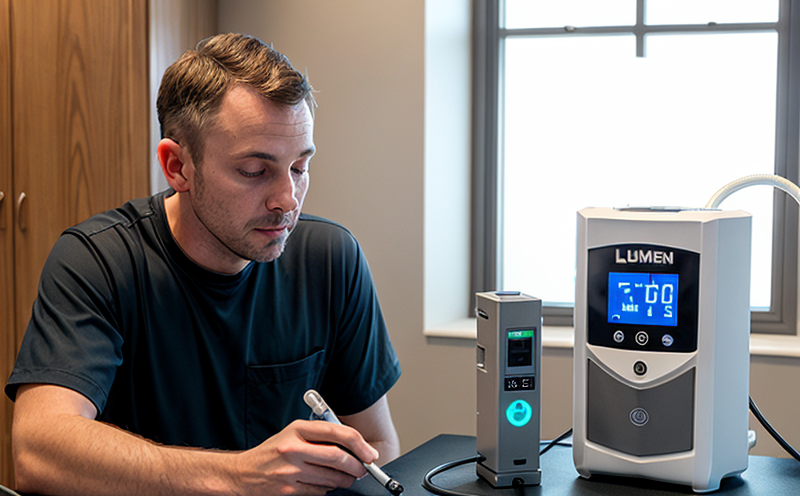IEC 62717 Lifetime Testing of LED Modules for General Lighting
The International Electrotechnical Commission (IEC) Standard 62717 is specifically designed to evaluate the long-term performance and reliability of LED modules used in general lighting applications. This standard ensures that manufacturers meet stringent requirements regarding lumen maintenance over the expected lifetime of their products, which typically ranges from 50,000 to 150,000 hours depending on the application.
IEC 62717 is particularly important for ensuring compliance with global regulations and industry standards. It helps manufacturers demonstrate that their LED modules will maintain their specified performance levels throughout their operational life. This not only enhances consumer trust but also supports regulatory requirements in various countries around the world.
The testing process involves subjecting LED modules to accelerated aging conditions designed to mimic real-world usage scenarios over extended periods. These tests are conducted under controlled environmental conditions that simulate typical operating temperatures, humidity levels, and electrical stress. The goal is to identify any potential failures or degradation before the product reaches the market.
During these tests, key performance metrics such as lumen output, color maintenance, and electrical efficiency are continuously monitored. Lumen maintenance refers to how much light a LED emits relative to its initial luminous flux after a certain period of use. This metric is crucial because it directly impacts the quality and longevity of lighting fixtures.
Understanding these parameters helps manufacturers optimize their designs and materials selection, leading to more efficient and longer-lasting products. For instance, selecting high-quality components early in the design phase can significantly improve overall performance and reliability. Additionally, proper thermal management strategies are essential for maintaining consistent lumen output over time.
The rigorous nature of IEC 62717 ensures that only high-quality LED modules make it to market, thereby protecting consumer interests and promoting sustainable practices within the lighting industry.
Applied Standards
The primary standard applied in this service is IEC 62717:2013 LED modules for general lighting applications – Determination of lumen maintenance and lifetime. This international standard provides a framework for testing the long-term performance characteristics of LED modules intended for use in general illumination systems. It specifies procedures, test methods, and criteria to evaluate lumen maintenance and determine the expected useful life of these components.
IEC 62717 is widely recognized by lighting manufacturers, regulatory bodies, and industry professionals due to its comprehensive approach towards assessing LED module performance. Compliance with this standard ensures that products meet stringent quality benchmarks, which are critical for maintaining trust among consumers who rely on reliable lighting solutions in their daily lives.
Other relevant standards include those from organizations like ANSI, UL, and national standards bodies such as ÖNORM. These additional standards complement IEC 62717 by addressing specific aspects of LED module design, installation, maintenance, and safety.
By adhering to multiple recognized international standards, our laboratory ensures that clients receive comprehensive evaluations that align with global expectations. This multi-faceted approach guarantees accurate assessments tailored to meet diverse regulatory requirements worldwide.
Scope and Methodology
| Parameter | Description |
|---|---|
| Lumen Output Measurement | Determine the initial lumen output of the LED module. This serves as a baseline for comparison with subsequent measurements taken during aging tests. |
| Aging Conditions | Simulate real-world operating conditions through controlled environmental chambers. Parameters include temperature, humidity, and electrical stress levels tailored to specific use cases. |
| Lifetime Estimation | Determine the number of hours required for the lumen output to decrease by a specified percentage (typically 30%) from its initial value. This defines the estimated useful life span of the LED module. |
| Color Maintenance | Monitor changes in color temperature and chromaticity coordinates over time to ensure consistent lighting quality throughout the product's lifecycle. |
| Electrical Efficiency Assessment | Evaluate how efficiently electrical power is converted into light energy. A high efficiency indicates better conversion rates, reducing energy consumption while maintaining brightness levels. |
The testing procedure involves subjecting LED modules to carefully controlled environments that replicate actual usage conditions. This includes exposure to varying temperatures and humidity levels, along with continuous operation under standard electrical loads. Throughout the process, detailed data on lumen output, color stability, and energy consumption are collected at regular intervals.
Once the test period concludes, comparisons between initial and final readings provide insights into the module’s durability and effectiveness over time. Based on these findings, we issue comprehensive reports detailing compliance with IEC 62717 standards as well as any deviations or anomalies observed during testing.
Use Cases and Application Examples
The application of IEC 62717 lifetime testing extends across numerous sectors where reliable lighting is paramount. In commercial settings, such as offices, retail spaces, and public buildings, ensuring consistent lumen output ensures optimal working conditions and enhances aesthetics.
In industrial environments, robust LED modules are essential for maintaining safety standards and operational efficiency. Hospitals and healthcare facilities benefit from dependable lighting that supports critical tasks without compromising patient comfort or staff productivity.
Residential applications also see significant advantages from this testing method. Homeowners can expect longer-lasting fixtures with minimal maintenance needs, translating to cost savings over time. Additionally, the energy-efficient nature of compliant LED modules contributes positively towards sustainability goals.
The transportation sector is another area where reliable lighting plays a crucial role. Aircraft interiors, train compartments, and road signs all rely on consistent illumination for safety reasons. By adhering to IEC 62717 standards, manufacturers can guarantee the longevity and reliability of their products even in challenging environments.
Lastly, outdoor applications like streetlights and security installations require robust LED modules capable of withstanding harsh weather conditions. Properly tested components ensure uninterrupted service during adverse climatic events, enhancing public safety and reducing maintenance costs.





